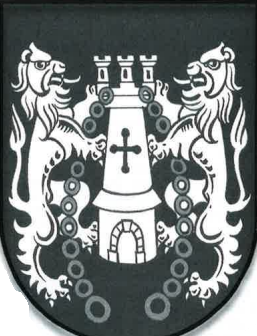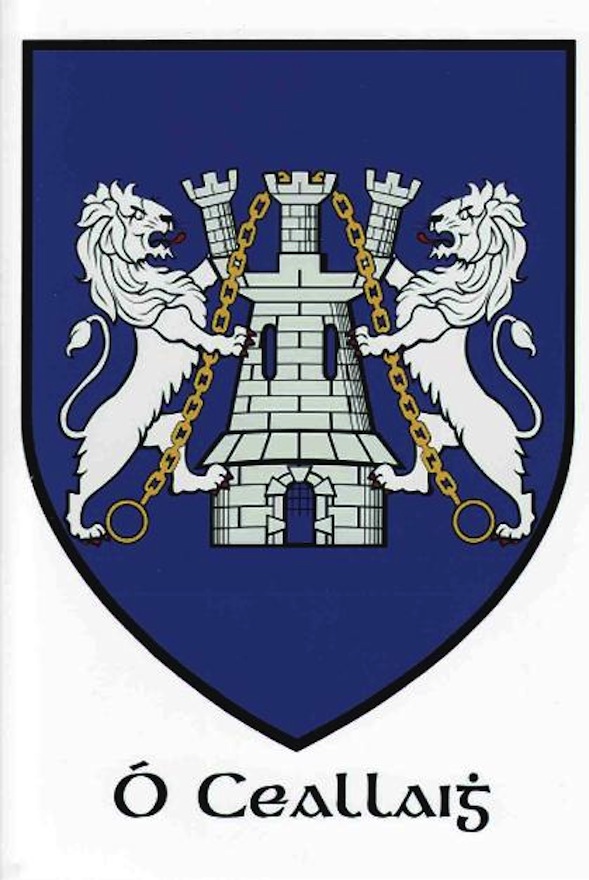Kelly is one of the most common Irish names and is found in all parts of the country. The spread and popularity of the name is due to the fact that it originates from at least seven different and unrelated ancient clans or septs. These include O’Kelly septs from Meath, Derry, Antrim, Laois, Sligo, Wicklow, Kilkenny, Tipperary, Galway and Roscommon, and the McKelly sept from East Connaught.
 One of the major septs is the O’Kellys of Ui Maine, or Hy Many, a territory in East Galway and South Roscommon. An authentic pedigree of this family exists from earliest times to the present day. The earliest parts of the O’Kelly genealogy is contained in the Book of Hy Many, which was written in the 14th century. Its compilation was the idea of William O’Kelly, chief of Hy Many.
One of the major septs is the O’Kellys of Ui Maine, or Hy Many, a territory in East Galway and South Roscommon. An authentic pedigree of this family exists from earliest times to the present day. The earliest parts of the O’Kelly genealogy is contained in the Book of Hy Many, which was written in the 14th century. Its compilation was the idea of William O’Kelly, chief of Hy Many.
The ancient annals record that this William O’Kelly gave a banquet for all the bards, poets and musicians of Ireland at Christmas, 1351. The Book of Hy Many was composed by nine scribes after William’s death. It is now kept in the Royal Irish Academy in Dublin.
O’Kelly derives from the Gaelic O Ceallaigh, meaning “descended from Ceallach.” The latter is an ancient personal name which is no longer used as a personal name in Ireland. The use of Kelly as a personal name in the U.S. (although rarely in Ireland) is an interesting reversion of the family name back to its original use. The name McKelly also exists, though far less commonly. As with many other families, the O’ or Mc has been dropped by most family members. A notable exception was Sean T. O’Kelly (18821966), who was President of Ireland from 1945 to 1959.
Kelly is reported to have been one of the most common Irish names listed among the early American records. On the muster rolls of the American Revolutionary Army, there are no less than 695 Kellys. These include Major John Kelly, who is remembered for his destruction of the bridge at Stonybrook during the American retreat from Trenton, thus saving American troops from capture.
Another famous American Kelly was Luther “Yellowknife” Kelly (1849-1928), who, almost unintentionally, became a famous U.S. Army scout. In 1865, he enlisted in the 10th Infantry not realizing it to be the regular army. After the war, not being able to gain release from the army, he was ordered west to Colorado, where he learned the Sioux language and customs and became familiar with the terrain. After his eventual release from the army, he became a hunter and trapper in the Yellowstone area. He subsequently rejoined the army as a guide to General Forsythe. As chief scout to General Wilson Miles, Kelly later served in several campaigns including those against Sitting Bull and against the Sioux and Cheyenne tribes. He also served as guide for the army in other areas of Colorado and later on an expedition to Alaska. Later in his extraordinary career, he headed a party of Marines in the Philippines and received special praise from President Roosevelt for his conduct in fighting off an attack by a large force of escaped convicts. He is buried at Kelly Mountain, Billings, Montana.
Also present with Yellowstone Kelly in the campaign against Sitting Bull was James O’Kelly (1845-1916). A war correspondent and politician, his life was no less remarkable. Born in Dublin, he joined the French Foreign Legion at age 18 and his regiment was sent to Mexico to support Emperor Maximilian. He was captured by the Mexican General Canales, but escaped and returned to France where he served as a captain in the French army. In 1870, he joined the New York Herald and was sent to Cuba to report on the Cuban revolt. There, he managed to penetrate the Cuban lines to interview General Caspades, President of the Republic. Captured by the Spanish, he avoided being shot as a spy only by diplomatic intervention. Among his other war reporting duties was the Mahdi revolt in the Sudan. Following his reporting of the Sitting Bull campaign, he returned to Ireland and became a Nationalist Member of Parliament in 1880. He remained a politician and newspaper correspondent until his death in 1916.
In the sporting field, Michael “King” Kelly (1857-1894) was one of the great baseball players of his era. He started with the Olympics of New Jersey, but made his name with the Chicago White-Stockings. In 1887, he was sold to Boston for the then record price of $10,000, earning him the nickname the “$10,000 Beauty.”
Grace Kelly (1929-1982), the film star who became Princess of Monaco, was the granddaughter of John Kelly from County Mayo. Her father, Jack Kelly, was a self-made millionaire and also an Olympic gold medalist in rowing. Her uncle, George Kelly, was a Pulitzer Prize winner.
Also in show business was the irrepressible Gene Kelly (1913-1996), star of such classics as Singin’ in the Rain and An American in Paris. Today writer and producer David Kelley dominates primetime television with the hits Ally McBeal and The Practice, while in visual arts, the painter Ellsworth Kelly holds sway.


Leave a Reply